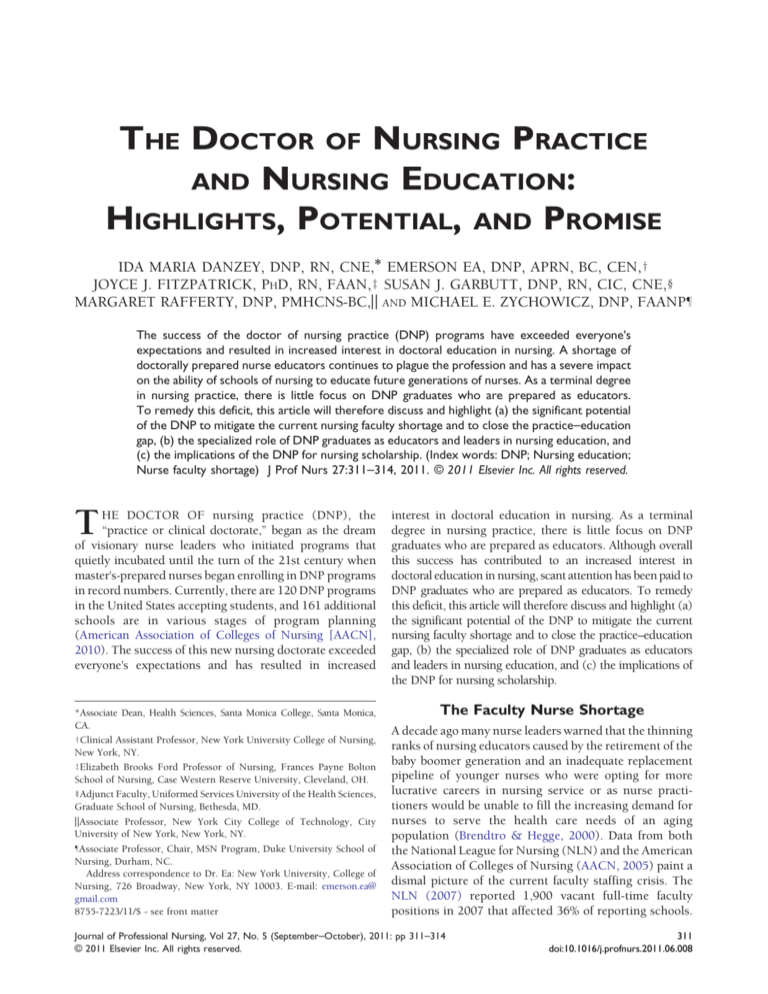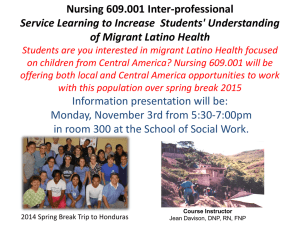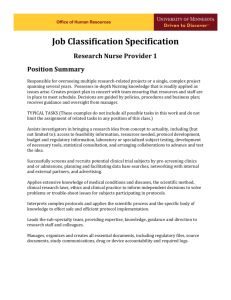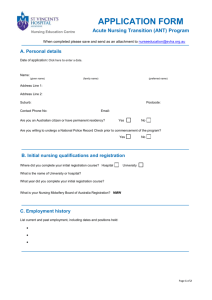
THE DOCTOR OF NURSING PRACTICE
AND NURSING EDUCATION:
HIGHLIGHTS, POTENTIAL, AND PROMISE
IDA MARIA DANZEY, DNP, RN, CNE,⁎ EMERSON EA, DNP, APRN, BC, CEN,†
JOYCE J. FITZPATRICK, PHD, RN, FAAN,‡ SUSAN J. GARBUTT, DNP, RN, CIC, CNE,§
MARGARET RAFFERTY, DNP, PMHCNS-BC,‖ AND MICHAEL E. ZYCHOWICZ, DNP, FAANP¶
The success of the doctor of nursing practice (DNP) programs have exceeded everyone's
expectations and resulted in increased interest in doctoral education in nursing. A shortage of
doctorally prepared nurse educators continues to plague the profession and has a severe impact
on the ability of schools of nursing to educate future generations of nurses. As a terminal degree
in nursing practice, there is little focus on DNP graduates who are prepared as educators.
To remedy this deficit, this article will therefore discuss and highlight (a) the significant potential
of the DNP to mitigate the current nursing faculty shortage and to close the practice–education
gap, (b) the specialized role of DNP graduates as educators and leaders in nursing education, and
(c) the implications of the DNP for nursing scholarship. (Index words: DNP; Nursing education;
Nurse faculty shortage) J Prof Nurs 27:311–314, 2011. © 2011 Elsevier Inc. All rights reserved.
T
HE DOCTOR OF nursing practice (DNP), the
“practice or clinical doctorate,” began as the dream
of visionary nurse leaders who initiated programs that
quietly incubated until the turn of the 21st century when
master's-prepared nurses began enrolling in DNP programs
in record numbers. Currently, there are 120 DNP programs
in the United States accepting students, and 161 additional
schools are in various stages of program planning
(American Association of Colleges of Nursing [AACN],
2010). The success of this new nursing doctorate exceeded
everyone's expectations and has resulted in increased
interest in doctoral education in nursing. As a terminal
degree in nursing practice, there is little focus on DNP
graduates who are prepared as educators. Although overall
this success has contributed to an increased interest in
doctoral education in nursing, scant attention has been paid to
DNP graduates who are prepared as educators. To remedy
this deficit, this article will therefore discuss and highlight (a)
the significant potential of the DNP to mitigate the current
nursing faculty shortage and to close the practice–education
gap, (b) the specialized role of DNP graduates as educators
and leaders in nursing education, and (c) the implications of
the DNP for nursing scholarship.
*Associate Dean, Health Sciences, Santa Monica College, Santa Monica,
CA.
†Clinical Assistant Professor, New York University College of Nursing,
New York, NY.
‡Elizabeth Brooks Ford Professor of Nursing, Frances Payne Bolton
School of Nursing, Case Western Reserve University, Cleveland, OH.
§Adjunct Faculty, Uniformed Services University of the Health Sciences,
Graduate School of Nursing, Bethesda, MD.
‖Associate Professor, New York City College of Technology, City
University of New York, New York, NY.
¶Associate Professor, Chair, MSN Program, Duke University School of
Nursing, Durham, NC.
Address correspondence to Dr. Ea: New York University, College of
Nursing, 726 Broadway, New York, NY 10003. E-mail: emerson.ea@
gmail.com
8755-7223/11/$ - see front matter
The Faculty Nurse Shortage
A decade ago many nurse leaders warned that the thinning
ranks of nursing educators caused by the retirement of the
baby boomer generation and an inadequate replacement
pipeline of younger nurses who were opting for more
lucrative careers in nursing service or as nurse practitioners would be unable to fill the increasing demand for
nurses to serve the health care needs of an aging
population (Brendtro & Hegge, 2000). Data from both
the National League for Nursing (NLN) and the American
Association of Colleges of Nursing (AACN, 2005) paint a
dismal picture of the current faculty staffing crisis. The
NLN (2007) reported 1,900 vacant full-time faculty
positions in 2007 that affected 36% of reporting schools.
Journal of Professional Nursing, Vol 27, No. 5 (September–October), 2011: pp 311–314
© 2011 Elsevier Inc. All rights reserved.
311
doi:10.1016/j.profnurs.2011.06.008
312
Among the reporting schools, almost 80% found recruitment of faculty holding a master's degree either “difficult”
or “very difficult” (NLN, 2007). By 2008, the faculty
vacancy rate was creeping up toward 10% (Allan &
Aldebron, 2008). However, by 2009, the nurse faculty
vacancy rate had decreased to 6%, no doubt a reaction to
the economic recession that postponed the retirements of
many nurse faculty effectively offering a temporary partial
reprieve (AACN, 2009). According to the 2009–2010
AACN Special Survey on Vacant Faculty Positions, almost
56% of nursing school survey respondents reported
faculty positions left unfilled (Fang & Tracy, 2009).
The current nurse faculty shortage is compounded by
a shortfall of doctorally prepared nursing faculty. Data
from 2004 indicated that less than 1% of nurses (26,100)
were educated at the doctoral level (Potempa, Redman,
& Landstrom, 2009). In 2001, only half- of full-time
nurse faculty in schools of nursing with baccalaureate
and graduate programs had doctoral degrees (Berlin &
Sechrist, 2002). The situation for associate degree and
diploma nurse faculty is even more dismal with less than
7% holding a doctoral degree (NLN, 2005). Until the
recent expansion of DNP programs, the numbers of
doctorally prepared nurses were stagnant with graduations from nursing doctoral programs hovering around
400 annually (Potempa et al., 2009). The number of
advanced practice nurses enrolling in DNP programs is
growing rapidly, from 70 in 2009 to more than 5,000
last year (AACN, 2010). Another problem is that only
some of doctorally prepared nurses choose to stay in the
academe. Many sought employment in nursing service
lured by more competitive salaries (Fitzpatrick, 2008;
Potempa et al., 2009).
The ramifications of a shortage of qualified nurse
faculty have significant implications to nursing education
and practice. Virtually every nursing organization has
reported that qualified student applicants to schools of
nursing have been turned away due in large part to the
nurse faculty shortage and limited clinical sites (AACN,
2009; Potempa et al., 2009; Pullen, Mueller & Ashcraft,
2009; Rother & Lavizzo-Mourey, 2009). The NLN
estimated that “75 % of the current faculty population is
expected to retire by 2019” (NLN, 2005), and one
conservative estimate projected that between 200 and
300 doctorally prepared faculty are eligible to retire each
year (Berlin & Sechrist, 2002). Nurse educators, professional organizations, policy makers, and politicians have
recommended a host of creative solutions (AACN, 2009;
Allan & Aldebron, 2008; Berlin & Sechrist, 2002; Foxall,
Erickson Megel, Grigsby & Billings, 2009; MacIntyre,
Murray, Teel & Karshmer, 2009; Potempa et al., 2009).
However, given the projected numbers and the limited
implementation of previously proposed solutions, the
looming crisis scenario is hard to ignore. A viable solution
is to recruit DNP graduates to assume faculty roles and
provide opportunities for DNP students to take electives
in nursing education or specialize in nursing education in
DNP programs. These might just be the innovations and/
or solutions that our profession needs to address the nurse
DANZEY ET AL
faculty shortage and to significantly narrow the gap
between practice and education.
DNP and Nursing Education
DNP programs that offer education elective courses or
education leadership options provide experienced
master's-prepared nurses with formal preparation in
educational theory, testing, evaluation, curriculum
development, and a capstone educational practicum.
The DNP degree with a focus on education embodies
all aspects of the NLN Core Competencies for Nurse
Educators (2005).
The DNP program at the Frances Payne Bolton School
of Nursing at Case Western Reserve University provides
an exemplar. Its educational leadership concentration
option prepares master's-prepared nurses for faculty roles
in clinical and academic settings. Graduates of these
programs are fluent in the application of the core
competencies of nurse educators and can implement
evidence-based teaching practices. As part of the program
requirements, students are expected to complete a
teaching practicum and a research project or thesis.
Consequently, these graduates are well prepared to
develop, implement, and evaluate nursing curriculum
based on contemporary practice standards such as the
Quality and Safety Education for Nurses and the Institute
of Medicine core competencies for health providers and
to develop, implement, and evaluate innovative teaching
strategies among others.
The most recent book by Benner, Sutphen, Leonard,
and Day (2010) critically evaluated our current nursing
education system and confirmed what we already know
as fact: that there is a need to change how we currently
prepare future nurses. The findings described in this
timely publication have strongly advocated the need for
nursing education and practice to come together and
have called for innovative teaching and learning approaches to prepare future nurses (Benner et al., 2010).
The nursing profession continues to struggle to bridge
the disconnect between theory and practice, and it is now
becoming very clear that we need to change the way we
educate future nurses and need to look at innovative ways
to continue to meet current and future health care
demands. The emergence of DNP as the terminal practice
doctorate does not only advance our profession but also
provides our profession the opportunity to close the gap
between education and practice.
The need for competent nurse educators who are
prepared for the many rigors and demands of a faculty
role has been well supported by both the AACN (2010)
and the NLN (2005). DNP-prepared faculty have the
clinical expertise and the practical and theoretical
knowledge to be an excellent resource and role model
to future nurses. After all, nursing is first and foremost
a practice profession. Moreover, DNP-prepared faculty
will enhance the credibility of the nurse educator role.
DNP-prepared nursing faculty can serve as both
mediators and translators between nursing education
and nursing practice.
DOCTOR OF NURSING PRACTICE AND NURSING EDUCATION
In addition, DNP-prepared nurse educators are well
poised to assume leadership roles in academia. DNPprepared nurses are contributing significantly to
nursing education in academic leadership roles such
as dean, director, or administrator of nursing programs
and schools. Their contributions and leadership can be
witnessed at small nursing programs at liberal arts
colleges and schools of nursing at large researchintensive universities.
The preparation these leaders receive during their
DNP education prepares them well for their role in
academic leadership. The AACN DNP Essentials (2006),
especially Essential II (Organizational and Systems
Leadership for Quality Improvement and Systems
Thinking) is especially pertinent for the leader in an
academic setting. This Essential ensures that the DNP
graduate is prepared with essential skills such as
advanced communication and the ability to lead quality
improvement initiatives. Business, finance, economic,
and health policy principles are components of this
Essential. In addition, this Essential encompasses administrative and leadership skills for the DNP such as
understanding organizational culture, analysis of initiatives, and budgetary development.
The DNP academic administrator is fully prepared to
engage in organizational evaluation and change and has a
firm understanding of organizational and health systems
and the capacity to be a change agent.
DNP and Scholarship
DNP-prepared faculty are engaged in advancing the
scholarship of nursing using Boyer's Model of Scholarship. Boyer's definition of scholarship has been used with
relevance and application to defining scholarship in
nursing. Boyer describes four areas: (a) scholarship of
discovery; (b) scholarship of teaching; (c) scholarship of
practice, and (d) scholarship of integration (Boyer, 1990).
As the number of DNP-prepared faculty increases, there
will be a growing recognition of their contribution to the
nursing profession in strengthening nursing scholarship.
The DNP expert clinician who is in the educator role is
engaged in the scholarship of teaching. The DNPprepared faculty member role models and shares his or
her advanced clinical knowledge and understanding of
the discipline of nursing with students. Development and
evaluation of teaching methods, innovative programs,
and program outcomes are also demonstrative of
activities DNP faculty members conduct, which are
reflective of the scholarship of teaching (AACN, 1999;
Loomis, Willard, & Cohen, 2007). Moreover, Boyer
(1996) envisions that the scholarship of teaching shapes
both research and practice.
As a clinical expert and scholar clinician, DNP faculty
members who are engaged in clinical practice as a
component of their faculty position are engaged in the
scholarship of application. These faculty members
continue to develop clinical and professional abilities.
Dissemination of clinical expertise through peerreviewed publications or professional presentations are
313
other examples of engagement in the scholarship of
application (AACN, 1999; Loomis et al., 2007).
The generation of new knowledge, which has been
traditionally used to define and measure academic
scholarship, falls within the Scholarship of Discovery.
The DNP-prepared faculty is generally educated with a
greater emphasis on the translation of research into
practice rather than the generation of new research. This
information-sharing endeavor that fuels the theory–
research–application cycle is an important pillar of
scholarship. The DNP-prepared nurse faculty could
play pivotal roles in this cyclical dynamic and could
effectively partner with nurse scientists in building
nursing knowledge and improving practice or take a
lead role in clinical research projects (AACN, 1999;
Boyer, 1990; Loomis et al., 2007). This is the type of
collaboration espoused by nursing organization and
nursing leaders.
The scholarship of integration describes the interdisciplinary scholarship that is engaged in by faculties.
DNP faculty members can and do engage in this form
of scholarship. There is no doubt that DNPs can
participate in interdisciplinary work to interpret and
bring new insight to original research, thereby revealing
research data in a novel and more meaningful way in a
new or greater context (AACN, 1999; Boyer, 1990;
Loomis et al., 2007).
Summary
We are currently witnessing an interesting and important
phase in our profession. The emergence of DNP as a
terminal degree in nursing practice has given our
profession the much needed ‘shot in the arm' to
reexamine our discipline. Although some view this as a
negative disruption to our advancement as a discipline,
there are many others who consider this as positive
initiative. This article discusses the contribution of DNPprepared educators in nursing education. As an advanced
and specialized role, DNP-prepared nurse educators and
leaders in nursing education would significantly contribute to the advancement of this ever-evolving profession.
References
Allan, J. D., & Aldebron, J. (2008). A systematic assessment
of strategies to address the nursing faculty shortage, U.S.
Nursing Outlook, 56, 286–297.
American Association of Colleges of Nursing (AACN).
(1999). Position statement on defining scholarship for the
discipline of nursing. Washington, DC: Author.
American Association of Colleges of Nursing (AACN).
(2005). Faculty shortages in baccalaureate and graduated
nursing programs: Scope of the problem and strategies for
expanding the supply. Retrieved October 5, 2009, from http://
wwwaacn.nche.edu.
American Association of Colleges of Nursing (AACN).
(2006). The essentials of doctoral education for advanced
nursing practice. Retrieved from http://www.aacn.nche.edu.
American Association of Colleges of Nursing (AACN).
(2009). Nursing faculty shortage fact sheet. Retrieved from
http://www.Aacn.nche.edu.
314
American Association of Colleges of Nursing (AACN).
(2010). The doctor of nursing practice (DNP) Fact Sheet
March 2010. Retrieved from http://www.aacn.nche.edu.
Benner, P., Sutphen, M., Leonard, V., & Day, L. (2010).
Educating nurses: A call for radical transformation. San Francisco:
Jossey-Bass.
Berlin, L., & Sechrist, K. (2002). The shortage of doctorally
prepared nursing faculty: A dire situation. Nursing Outlook, 50,
50–56.
Brendtro, M., & Hegge, M. (2000). Nursing faculty: One
generation away from extinction? Journal of Professional
Nursing, 16, 97–103.
Boyer, E. (1990). Scholarship reconsidered: Priorities for the
professorate. Princeton, NJ: The Carnegie Foundation for the
Advancement of Teaching.
Boyer, E. L. (1996). Clinical practice as scholarship. Holistic
Nursing Practice, 10, 1–6.
Fang, D., & Tracy, C. (2009). Special survey on vacant
faculty positions for academic year 2009–2010. Retrieved
October 1, 2009, from http://www.aacn.nche.edu.
Fitzpatrick, J. (2008). The #1 cause of the faculty shortage?
It's the money! Nursing Education Perspectives, 29, 253.
Foxall, M., Megel, M. E., Grigsby, K., & Billings, J. S. (2009).
Faculty retirement: Stemming the tide. Journal of Nursing
Education, 48, 172–175.
DANZEY ET AL
Loomis, J. A., Willard, B., & Cohen, J. (2007). Difficult
professional choices: Deciding between the PhD and the DNP
in nursing. Online Journal of Issues in Nursing, 12, 16.
Retrieved October 8, 2009, from http://www.nursingworld.
org/MainMenuCategories/ANAMarketplace/ANAPeriodicals/
OJIN.aspx.
MacIntyre, R. C., Murray, T. A., Teel, C. S., & Karshmer, J. F.
(2009). Five recommendations for prelicensure nursing education. Journal of Nursing Education, 48, 447–453.
National League for Nursing (NLN). (2005). Nurse
faculty shortage fact sheet. Retrieved October 1, 2009,
http://www.nln.org.
National League for Nursing (NLN). (2007). Annual survey
of schools of nursing academic year 2006–2007: Executive
summary. Retrieved from http://www.nln.org/research/slides/
exec.
Potempa, K. M., Redman, R. W., & Landstrom, G. (2009).
Human resources in nursing education: A worldwide crisis.
Collegian, 16, 19–22.
Pullen, R. L., Mueller, S. S., & Ashcraft, J. L. (2009). Nursing
the numbers through faculty recruitment and student retention.
Nurse Educator, 34, 132–136.
Rother, J., & Lavizzo-Mourey, R. (2009). Addressing the
nursing workforce: A critical element for health reform.
Health Affairs, 28, w620–w624.






